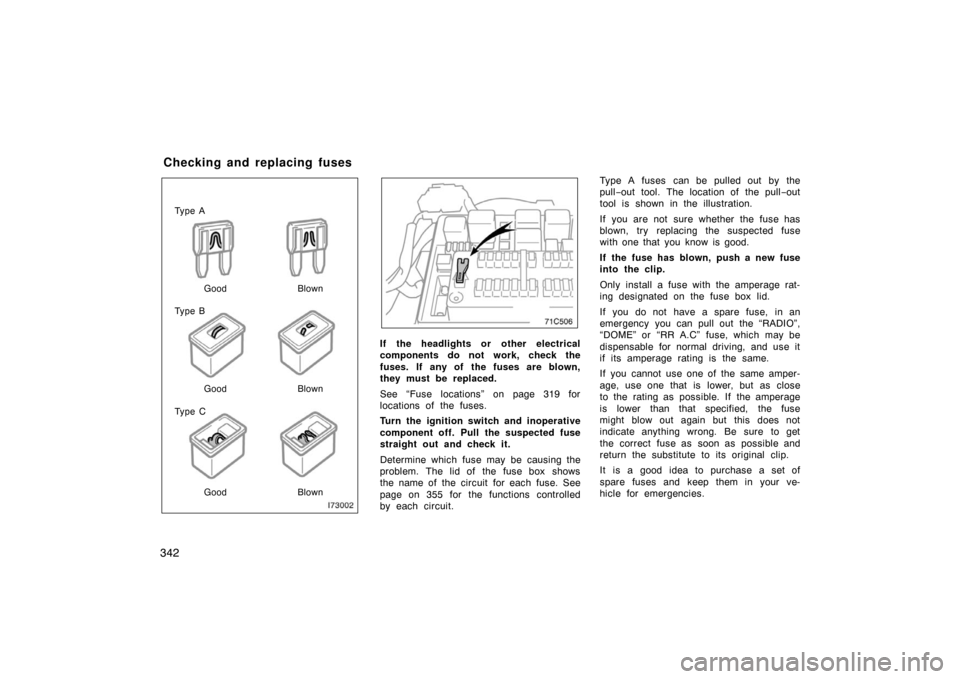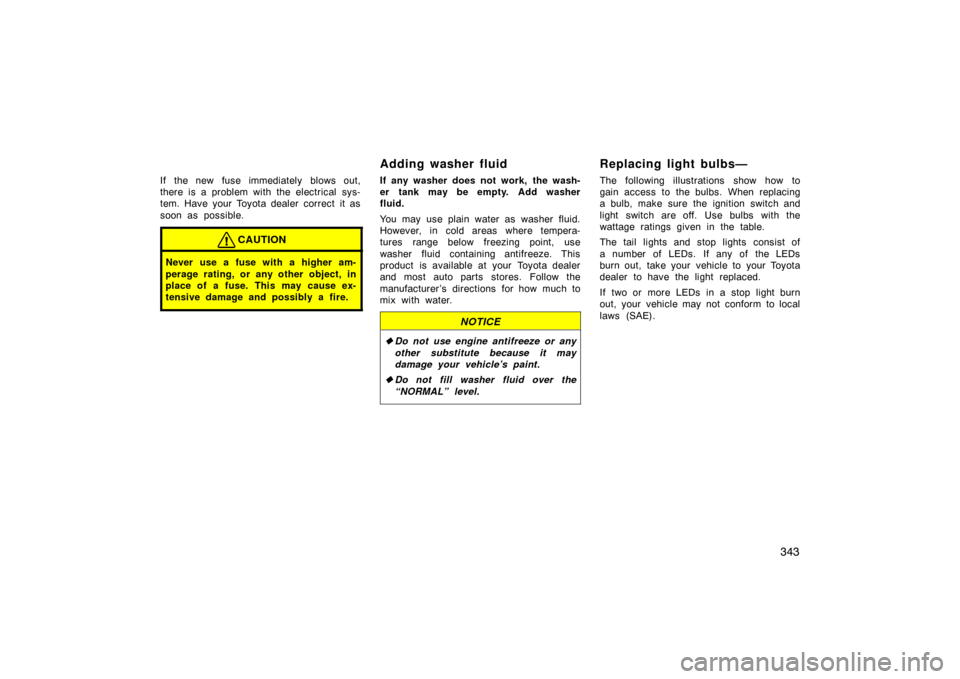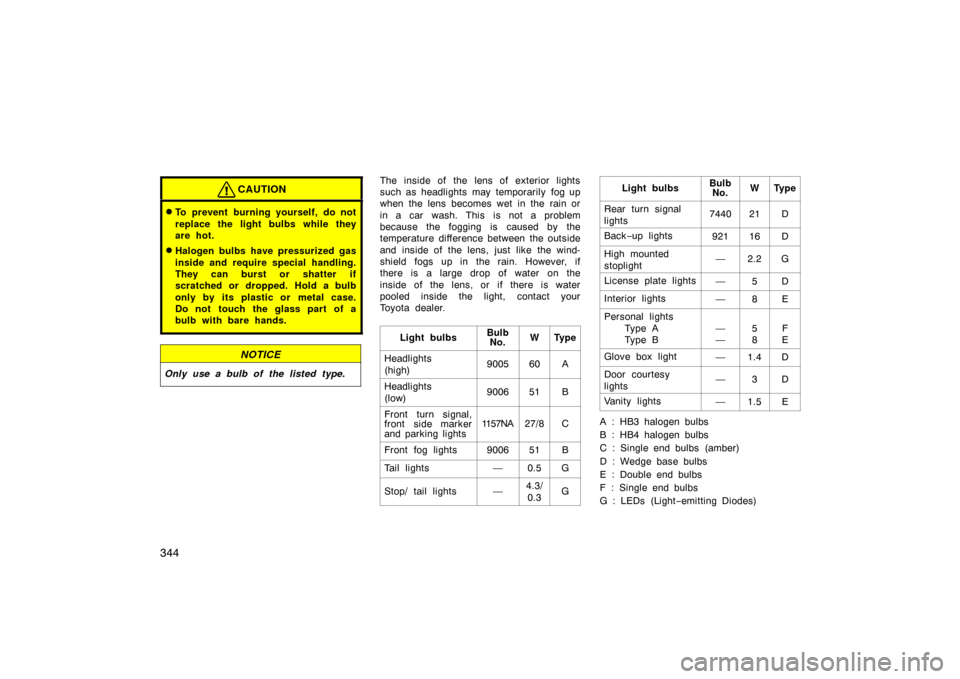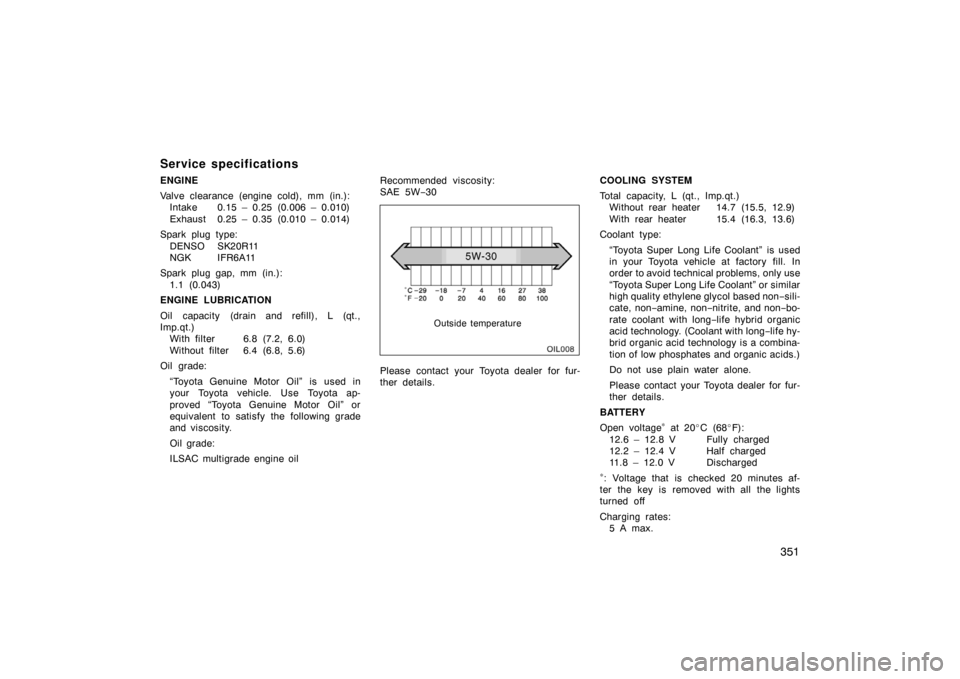Page 356 of 374

342
Ty p e A
Ty p e B
Ty p e CGood Blown
Good Blown
Good Blown
If the headlights or other electrical
components do not work, check the
fuses. If any of the fuses are blown,
they must be replaced.
See “Fuse locations” on page 319 for
locations of the fuses.
Turn the ignition switch and inoperative
component off. Pull the suspected fuse
straight out and check it.
Determine which fuse may be causing the
problem. The lid of the fuse box shows
the name of the circuit for each fuse. See
page on 355 for the functions controlled
by each circuit. Type A fuses can be pulled out by the
pull
−out tool. The location of the pull −out
tool is shown in the illustration.
If you are not sure whether the fuse has
blown, try replacing the suspected fuse
with one that you know is good.
If the fuse has blown, push a new fuse
into the clip.
Only install a fuse with the amperage rat-
ing designated on the fuse box lid.
If you do not have a spare fuse, in an
emergency you can pull out the “RADIO”,
“DOME” or “RR A.C” fuse, which may be
dispensable for normal driving, and use it
if its amperage rating is the same.
If you cannot use one of the same amper-
age, use one that is lower, but as close
to the rating as possible. If the amperage
is lower than that specified, the fuse
might blow out again but this does not
indicate anything wrong. Be sure to get
the correct fuse as soon as possible and
return the substitute to its original clip.
It is a good idea to purchase a set of
spare fuses and keep them in your ve-
hicle for emergencies.
Checking and replacing fuses
Page 357 of 374

343
If the new fuse immediately blows out,
there is a problem with the electrical sys-
tem. Have your Toyota dealer correct it as
soon as possible.
CAUTION
Never use a fuse with a higher am-
perage rating, or any other object, in
place of a fuse. This may cause ex-
tensive damage and possibly a fire.
Adding washer fluid
If any washer does not work, the wash-
er tank may be empty. Add washer
fluid.
You may use plain water as washer fluid.
However, in cold areas where tempera-
tures range below freezing point, use
washer fluid containing antifreeze. This
product is available at your Toyota dealer
and most auto parts stores. Follow the
manufacturer’s directions for how much to
mix with water.
NOTICE
�Do not use engine antifreeze or any
other substitute because it may
damage your vehicle’s paint.
� Do not fill washer fluid over the
“NORMAL” level.
Replacing light bulbs—
The following illustrations show how to
gain access to the bulbs. When replacing
a bulb, make sure the ignition switch and
light switch are off. Use bulbs with the
wattage ratings given in the table.
The tail lights and stop lights consist of
a number of LEDs. If any of the LEDs
burn out, take your vehicle to your Toyota
dealer to have the light replaced.
If two or more LEDs in a stop light burn
out, your vehicle may not conform to local
laws (SAE).
Page 358 of 374

344
CAUTION
�To prevent burning yourself, do not
replace the light bulbs while they
are hot.
�Halogen bulbs have pressurized gas
inside and require special handling.
They can burst or shatter if
scratched or dropped. Hold a bulb
only by its plastic or metal case.
Do not touch the glass part of a
bulb with bare hands.
NOTICE
Only use a bulb of the listed type.
The inside of the lens of exterior lights
such as headlights may temporarily fog up
when the lens becomes wet in the rain or
in a car wash. This is not a problem
because the fogging is caused by the
temperature difference between the outside
and inside of the lens, just like the wind-
shield fogs up in the rain. However, if
there is a large drop of water on the
inside of the lens, or if there is water
pooled inside the light, contact your
Toyota dealer.Light bulbs
BulbNo.WTy p e
Headlights
(high)900560A
Headlights
(low)900651B
Front turn signal,
front side marker
and parking lights1157NA27/8C
Front fog lights900651B
Tail lights—0.5G
Stop/ tail lights—4.3/
0.3G
Light bulbsBulb No.WTy p e
Rear turn signal
lights744021D
Back −up lights92116D
High mounted
stoplight—2.2G
License plate lights—5D
Interior lights—8E
Personal lights
Ty p e A
Ty p e B
—
—5
8F
E
Glove box light—1.4D
Door courtesy
lights—3D
Vanity lights—1.5E
A : HB3 halogen bulbs
B : HB4 halogen bulbs
C : Single end bulbs (amber)
D : Wedge base bulbs
E : Double end bulbs
F : Single end bulbs
G : LEDs (Light −emitting Diodes)
Page 359 of 374
345
—Headlights
73c005a
1. Open the hood.Left�hand headlight: Remove the
washer inlet.
Be careful not to spill the washer fluid
over the “NORMAL” level.
Do not place the washer inlet on the en-
gine or battery.2. Left�hand headlight and right�hand head light (high beam):
Turn the bulb base counterclockwise
to the front of the vehicle.
Right�hand headlight (low beam):
Turn the bulb base clockwise to the
front of the vehicle.3. Pull the bulb out of the bulb base.
If the connector is tight, wiggle it.
Page 360 of 374
346
4. Left�hand headlight and right�handheadlight (high beam):
Install the bulb base by turning it
clockwise to the front of the vehicle.
Right�hand headlight (low beam):
Install the bulb base by turning it
counterclockwise to the front of the
vehicle.
Left�hand headlight: Remove the
washer inlet.
Aiming is not necessary after replacing
the bulb. When aiming adjustment is nec-
essary, contact your Toyota dealer.
—Front fog lights
1. Turn the bulb base counterclockwise to the front of the vehicle as shown.2. Pull the bulb out of the bulb base.
If the connector is tight, wiggle it.
Page 361 of 374
347
3. Install a new bulb base by turning itclockwise to the front of the vehicle.
Aiming is not necessary after replacing
the bulb. When aiming adjustment is nec-
essary, contact your Toyota dealer. If the left or right front turn signal and
front side marker light burn out, con-
tact your Toyota dealer.
NOTICE
Do not try to replace the front turn
signal and front side marker light
bulbs by yourself. You may damage
the vehicle.
Use a flathead screwdriver.
—Front turn signal and front
side marker lights
—Rear turn signal and back–
up lights
Page 362 of 374
348
a
b
a: Rear turn signal light
b: Back–up light
—License plate lights
Page 365 of 374

351
Service specifications
ENGINE
Valve clearance (engine cold), mm (in.):Intake 0.15 – 0.25 (0.006 – 0.010)
Exhaust 0.25 – 0.35 (0.010 – 0.014)
Spark plug type: DENSO SK20R11
NGK IFR6A11
Spark plug gap, mm (in.): 1.1 (0.043)
ENGINE LUBRICATION
Oil capacity (drain and refill), L (qt.,
Imp.qt.) With filter 6.8 (7.2, 6.0)
Without filter 6.4 (6.8, 5.6)
Oil grade:
“Toyota Genuine Motor Oil” is used in
your Toyota vehicle. Use Toyota ap-
proved “Toyota Genuine Motor Oil” or
equivalent to satisfy the following grade
and viscosity.
Oil grade:
ILSAC multigrade engine oil Recommended viscosity:
SAE 5W
−30
Outside temperature
Please contact your Toyota dealer for fur-
ther details. COOLING SYSTEM
Total capacity, L (qt., Imp.qt.)
Without rear heater 14.7 (15.5, 12.9)
With rear heater 15.4 (16.3, 13.6)
Coolant type:
“Toyota Super Long Life Coolant” is used
in your Toyota vehicle at factory fill. In
order to avoid technical problems, only use
“Toyota Super Long Life Coolant” or similar
high quality ethylene glycol based non −sili-
cate, non −amine, non− nitrite, and non− bo-
rate coolant with long −life hybrid organic
acid technology. (Coolant with long −life hy-
brid organic acid technology is a combina-
tion of low phosphates and organic acids.)
Do not use plain water alone.
Please contact your Toyota dealer for fur-
ther details.
BATTERY
Open voltage
∗ at 20 �C (68 �F):
12.6 – 12.8 V Fully charged
12.2 – 12.4 V Half charged
11.8 – 12.0 V Discharged
∗: Voltage that is checked 20 minutes af-
ter the key is removed with all the lights
turned off
Charging rates: 5 A max.